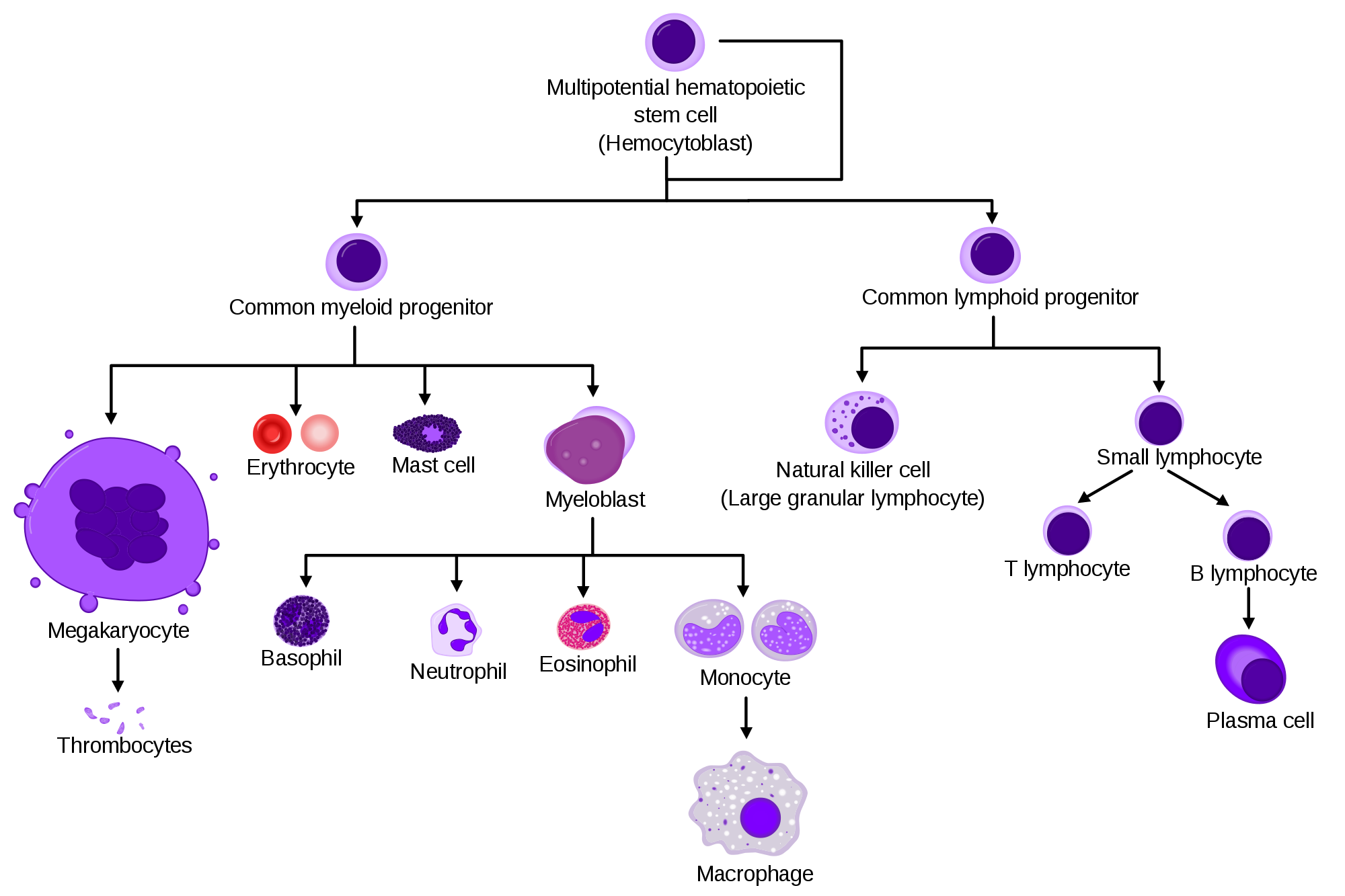
Pathology
Immune Responses
Which of the following is NOT a granulocyte:
Answer:
The white blood cells (leucocytes) may be divided into two broad groups: the phagocytes and the lymphocytes. Phagocytes comprise the cells of the innate immune system, which can act very quickly after an infection, whereas lymphocytes mediate the adaptive immune response, which can develop immunological memory. Phagocytes can themselves be divided into granulocytes (neutrophils, eosinophils and basophils) and monocytes/macrophages.Immune Response
Pathology / Immune Responses
Last Updated: 8th October 2025
The white blood cells (leucocytes) may be divided into two broad groups: the phagocytes and the lymphocytes. Phagocytes comprise the cells of the innate immune system, which can act very quickly after an infection, whereas lymphocytes mediate the adaptive immune response, which can develop immunological memory. Phagocytes can themselves be divided into granulocytes (neutrophils, eosinophils and basophils) and monocytes. The function of phagocytes and lymphocytes in protecting the body against infection is closely connected with two soluble protein systems of the body, immunoglobulins and complement.

Haemopoiesis. (Image by Mikael Häggström and A. Rad [CC BY-SA 3.0 (http://creativecommons.org/licenses/by-sa/3.0/)])
Innate Immune Response
Tissue damage and invasion of phagocytes activates mast cells and resident phagocytes, primarily macrophages and dendritic cells, which release inflammatory mediators, cytokines and cytotoxic agents. Inflammatory mediators cause vasodilation (heat and redness), stimulate nociceptors, (pain), and increase endothelial permeability, leading to extravasation of protein and fluids and thus oedema (swelling).
Cytokines (e.g. interleukin-8, IL-8) attract many more phagocytes, chiefly neutrophils (chemotaxis); these leave the blood by squeezing between endothelial cells. Phagocytes ingest microorganisms, and in the case of macrophages also damaged cells and debris. Pathogens can be detected because they express pathogen-associated molecular patterns (PAMPs) not found in mammals. PAMPs are recognised by phagocyte pattern recognition receptors (PRRs). Injured, infected or cancerous cells express PAMP-like molecules recognised by natural killer cells, which kill the cells and activate macrophages to remove the debris. In major infections, cytokines such as IL-1 cause fever; high temperatures may assist the immune response.
Complement is an important non-cellular mechanism comprised of a cascade of plasma proteins. On activation it coats and opsonises pathogens for phagocytosis, kills by membrane rupture, recruits phagocytes and induces inflammation. It is activated by some surface molecules and by antibodies that have 'tagged' a pathogen as foreign.
Adaptive Immune Response
The adaptive response takes ~5 days to become effective, and peaks after 1-2 weeks. It involves a cell-mediated response involving T-cells and a humoral response involving B-cells and antibodies.
Cell-Mediated Immunity:
Cell-mediated immunity is directed towards antigen within cells, which are made visible by class I major histocompatibility complex (MHC I). MHC I is found on the surface of cells and displays antigen to cytotoxic T cells, which proliferate on recognising the antigen and destroy the infected cell.
Humoral Immunity:
Humoral immunity is particularly effective against extracellular pathogens, as it involves secretion of antibodies into extracellular fluid. When an antigen binds to its matching receptor on naive B-cells, the latter activate and undergo clonal expansion. These differentiate into plasma cells which secrete antibody in massive amounts. T helper cells substantially enhance the response if the antigen is a protein. Memory cells which persist for years are also produced during clonal expansion. These respond much more rapidly and powerfully to subsequent exposures to the same pathogen and provide long-term immunity.
T helper cells only recognise protein antigens when they are presented to them by class II major histocompatibility complex (MHC II) on antigen presenting cells (APCs), which include dendritic cells, macrophages and activated B-cells. If they recognise the antigen, the cell proliferates and releases cytokines which strongly potentiate B-cell proliferation and performance. They also release cytokines that regulate the activity of other immune cells.
Report A Problem
Is there something wrong with this question? Let us know and we’ll fix it as soon as possible.
Loading Form...
- Biochemistry
- Blood Gases
- Haematology
| Biochemistry | Normal Value |
|---|---|
| Sodium | 135 – 145 mmol/l |
| Potassium | 3.0 – 4.5 mmol/l |
| Urea | 2.5 – 7.5 mmol/l |
| Glucose | 3.5 – 5.0 mmol/l |
| Creatinine | 35 – 135 μmol/l |
| Alanine Aminotransferase (ALT) | 5 – 35 U/l |
| Gamma-glutamyl Transferase (GGT) | < 65 U/l |
| Alkaline Phosphatase (ALP) | 30 – 135 U/l |
| Aspartate Aminotransferase (AST) | < 40 U/l |
| Total Protein | 60 – 80 g/l |
| Albumin | 35 – 50 g/l |
| Globulin | 2.4 – 3.5 g/dl |
| Amylase | < 70 U/l |
| Total Bilirubin | 3 – 17 μmol/l |
| Calcium | 2.1 – 2.5 mmol/l |
| Chloride | 95 – 105 mmol/l |
| Phosphate | 0.8 – 1.4 mmol/l |
| Haematology | Normal Value |
|---|---|
| Haemoglobin | 11.5 – 16.6 g/dl |
| White Blood Cells | 4.0 – 11.0 x 109/l |
| Platelets | 150 – 450 x 109/l |
| MCV | 80 – 96 fl |
| MCHC | 32 – 36 g/dl |
| Neutrophils | 2.0 – 7.5 x 109/l |
| Lymphocytes | 1.5 – 4.0 x 109/l |
| Monocytes | 0.3 – 1.0 x 109/l |
| Eosinophils | 0.1 – 0.5 x 109/l |
| Basophils | < 0.2 x 109/l |
| Reticulocytes | < 2% |
| Haematocrit | 0.35 – 0.49 |
| Red Cell Distribution Width | 11 – 15% |
| Blood Gases | Normal Value |
|---|---|
| pH | 7.35 – 7.45 |
| pO2 | 11 – 14 kPa |
| pCO2 | 4.5 – 6.0 kPa |
| Base Excess | -2 – +2 mmol/l |
| Bicarbonate | 24 – 30 mmol/l |
| Lactate | < 2 mmol/l |

